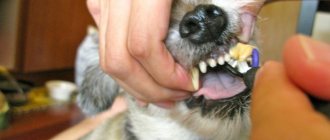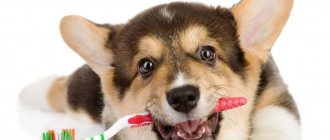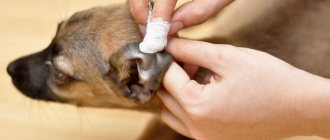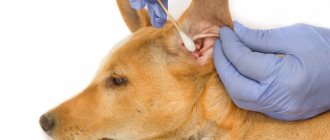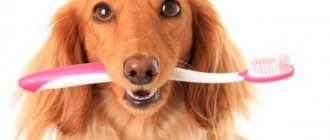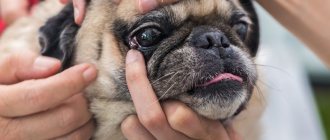The ear, as an organ of hearing, along with vision and smell, is extremely important for a dog. Dogs distinguish different sounds much better and more subtly, not least thanks to their large and finely constructed shells. In most dogs, they are large, abundantly supplied with blood vessels and nerve endings, as well as powerful muscles that can move them in the direction the dog needs to improve sound capture.
Like any other organ, ears need careful handling and careful care. Animals, like humans, produce special wax that is designed to lubricate and protect the ear canal. But when there is an excessive amount of it, water, dirt, or diseases enter it, it becomes a breeding ground for dangerous microorganisms. To keep your dog healthy, you need to know how to properly clean your dog's ears.
How to tell when it's time to clean your dog's ears
Due to the small stature of dogs, their ears become dirty with dust, splashes from puddles, grass, and insects. It is extremely important to keep these organs clean, but hygiene cannot be done every day.
Sebum and wax are essential to protect the delicate epidermis inside the ears. They protect the organ from sudden temperature fluctuations, mosquito bites and bugs. By removing the beneficial layer, you can harm your pet and cause microtraumas, inflammatory processes, fungi and bacterial diseases.
Moderation is important in everything. In lop-eared dogs, dirt accumulates faster in the ears due to the lack of adequate air circulation. To determine whether it is time to remove wax, you need to lift the skin and look into the sink. For breeds with erect ears, it is sufficient to carry out an examination once every 2 weeks.
A simple test will help you accurately determine the need for a hygiene procedure. A moistened cotton swab or swab should be rubbed along the inside of the dog's hearing aid. If the instrument is clean, you can postpone the event. If a small yellow or dirty coating forms, you must wait a few days. Identification of large lumps of sulfur requires their immediate removal.
How to clean your ears at home
Clean your ears once every 3-4 weeks. But each breed has its own nuances. For short-eared people whose ears are open, the procedure is carried out once every 5-7 days. The owner should inspect the animal's ears regularly.
Special products have been developed to remove wax from the ears of dogs.
Inspection
When examining the auricle, you need to pay attention to whether there is redness, discharge, or an unpleasant odor. If you notice any of the symptoms, you should take your pet to the veterinarian. You need to clean your animal's ears carefully so as not to damage the internal ones.
In dogs, the auditory canal is different from the human one; it is not straight, but curved.
Preparing for cleaning
Before cleaning, you need to prepare your pet's ears. You should moisten the shells with chilled green tea. Tea has an antibacterial effect. Do not pour the product into the ear canal.
Cleansing
For cleaning you will need cotton pads and swabs, wet wipes. Purification is carried out only in the external. The dog must be restrained by living on its side. If the organ hangs down, bend it.
Remove dissolved dirt with a damp cloth or moistened cotton pad. Remove excess wax with a rolled cotton swab, carefully moving down the ear canal. Then gently pull the stick up, wiping the ear canal.
Separate cotton pads and wet wipes should be used for each ear.
This will prevent infection from spreading from one sink to another.
Importance of the procedure
Cleaning a dog’s ear is a disease prevention and a way to promptly detect disorders that require a veterinary examination and proper treatment. The appearance of an unpleasant odor is a signal of problems. It could be a mite, yeast-like fungi, or bacteria.
Expert opinion
Anna Abramenko
An avid dog lover. Experience in veterinary medicine since 2009.
Ask a Question
Cleaning your ears on time is important. The question concerns not only the aesthetic side, but also health. When a large amount of sulfur secretions accumulates, a dog may develop otitis media. Parasites are often associated with inflammation.
Ear Problems in Dogs: Causes
Many factors can cause ear inflammation. Pus in the ear appears when secondary microflora joins and there is significant damage.
The main causes of otitis media:
- Allergic reactions.
- Atopy.
- Parasites.
- Infections.
- Alien agents.
- Neoplasms.
- Mixed reasons.
Humidity, increased secretion of sulfur, and lack of trimming of the ear canals contribute to the development of otitis media.
Relapses occur frequently due to incomplete treatment.
Owners, and many doctors, believe that a few drops of medicine in the ear for a week is enough, but this is not so. The course of treatment for purulent otitis is long, from three weeks.
You also need weekly monitoring by a doctor: otoscopy and cytological examination over time. Pus in a dog's ear is a serious problem.
Watch the video: Ear inflammation in dogs - Veterinarian explains how to treat
Ways to clean your ears
There are different techniques. The scheme is almost always the same, the only difference is in the means used.
Professional drugs
The pet store offers a wide range of lotions and gels for gentle care of dogs' ears. Each product comes with instructions, but the procedure is roughly the same.
Cleaning principle:
- pull back the ear;
- pour 2-3 drops of product into the sink;
- hold the dog so that it does not shake its head;
- perform a light massage for better distribution of fluid along the walls;
- After 2 minutes, wipe the inside of the ear with a cotton pad or swab treated with the same cleaning agent.
It is forbidden to immerse hard devices deep into the dog's ear. This risks damaging the eardrum and causing further problems.
Folk remedies
Chamomile infusion, string, mint, tea leaves, etc. are used. The instructions for use have one distinctive feature - the liquid is prohibited from pouring into the ear.
How to clean:
- Cool the prepared infusion to room temperature;
- Wipe the sink and ear canal with a dry cotton swab or disk;
- moisten another clean instrument in the prepared solution;
- treat the inside and hollows of the ear;
- wipe the sink dry.
How to treat dog ears: Otitis media
As mentioned above, treatment depends directly on the results of diagnostic procedures, the cause and type of otitis media.
For external use, broad-spectrum drops are used: Surolan, Izotik or narrow-spectrum Otofa.
For swelling of the ear canal, a short course of Prednisolone.
Atopica is additionally used systemically .
To treat otitis internal and media, long-term use of oral antibiotics is required over a long course and in high dosages, for example, Cephalexin.
Also, if there is a large amount of discharge in the ear, it may need to be rinsed under sedation. The doctor inserts a tube attached to a syringe containing warm sodium chloride into the ear and irrigates it generously to remove as much discharge as possible.
Surgical treatment is used, for example, in the presence of tumors in the ear - polyps or other types. Veterinarians may use laser, cryotherapy, or the traditional scalpel method for excision.
Watch the video: Massaging a Pug's Ear - Ear Treatment Demonstration
Frequency
The frequency of ear cleaning in different types of dogs depends on a large number of factors, among which a special place is given to the age of the pet and the structure of the hearing aid. Healthy puppies and young individuals undergo hygiene at intervals of 2-3 months. But this is an average value. To determine the need for the procedure, the following nuances must be taken into account:
- presence of heavy contamination;
- restless behavior, shaking the head, scratching the ears with paws;
- formation of scratches and wounds on the inner surface;
- accumulation of black plaque with a specific odor.
In these cases, it is recommended to carry out hygiene with chlorhexidine or miramistin. If after a short period of time wax or plaque has formed again, it is recommended to show the dog to a veterinarian.
How to accustom a dog to the procedure
The procedure should be carried out regularly. The dog should be accustomed to procedures from an early age. An animal accustomed to cleaning from childhood will not be stubborn and snap. You need to talk to the dog in a calm tone, carry out the procedure without aggression, minimizing stress for the animal.
An individual napkin, ear swab, and cotton pad are used for each ear.
An adult animal can be trained to the procedure. But training will take time and patience, and will depend on the breed of the dog. It is important to let your pet know that the procedure is not harmful and he can leave at any time.
The owner must maintain eye contact with the dog. The animal perceives this as a signal to communicate.
The training process should begin by calling the dog, then you need to stroke it, touching the ears. We can train service breeds faster than terriers.
Care products
The following options are suitable for carrying out hygiene procedures in the comfort of home:
- Wet wipes for dogs. Thanks to their softening impregnation, they effectively dissolve dirt and wax, but do not irritate delicate skin.
- Lotion. The most popular and sought-after cleaning product, capable of collecting all the secretions and removing them with a gentle massage or simple shaking of the head.
Expert opinion
Anna Abramenko
An avid dog lover. Experience in veterinary medicine since 2009.
Ask a Question
Lotions are not recommended for frequent use. Optimally – once a month. This medication is also contraindicated in dogs with perforated eardrums.
- Powder. A convenient option for hygiene of long ears. It dries out wax and absorbs moisture, which helps clean your dog’s hearing aid faster and more painlessly. Eliminates foul odor and kills bacteria.
- Cleaning drops. This product has several useful properties - disinfectant, medicinal, healing, antipruritic. They are used in the same way as lotions.
- Cotton buds. Replacement for gauze and tampons. They are impregnated with a solution, helping to better absorb moisture and remove dirt from the walls of the ears. It is recommended that the dog's ears be treated carefully with these devices to avoid injury.
If you don’t have professional products at home, you can clean your dog’s ears using the following liquids:
- Sea salt solution. Dilute 1 tsp in a glass of warm boiled water. salt, moisten the disc in this liquid and use it to remove deposits in the ear canal.
- Chlorhexidine. Pour a small amount of 0.5% antiseptic into each ear of the dog using a pipette; after a light massage, she should shake her head.
- Herbal infusions. Chamomile flowers and calendula have a healing, healing effect. They should not be put in the ears, but you can rinse them with a moistened swab or cotton swab.
- Green tea. Prepare a fresh drink, soak gauze or other device in it and use it to remove sulfur from inside the sink.
If a specific odor and itching appears from the ears, rinsing with hydrogen peroxide is recommended. Pour 5 drops of the 3% solution into each pass. For convenience, it is advisable to use a syringe without a needle for instillation. After the infusions, the dog will shake his head and everything will come out. Then the moisture is soaked with a dry towel.
Why is this necessary?
Dog ears are amazingly designed - they are capable of self-cleaning. The epithelial cells lining the ear canal migrate from the eardrum to the outside of the ear canal. Together with them, dust, hairs, a small amount of ear discharge, bacteria and yeast-like fungi are removed from the dog’s ear.
However, the tissue lining the ear canal is very delicate, thin and can be damaged by any careless intervention. Improper and rough cleaning with a cotton swab, tweezers or scissors with a bandage wrapped around the ends can injure the skin and disrupt the natural self-cleaning process of the ear canal.
A dog only needs deep ear cleaning if it is sick or inflamed. If the dog shakes its head, itches strongly and often in the ear area, there is an unpleasant smell from the ears or discharge - this is a reason to immediately consult a doctor. After examination, the veterinarian will prescribe drops or ointment. You will have to clean your ears using special products several times a day at home until complete recovery.
For a healthy pet, it is enough to regularly carry out hygienic cleaning, during which only the visible part of the auricle is treated with special, non-medicinal products. Contaminants are removed after a walk: dust, dirt, excess ear secretions, only from the outer part of the ear canal and the auricle. This is a preventive procedure to prevent foreign objects, dirt, and bacteria from entering the ear canal itself, and to prevent inflammation.
How often should you carry out preventive ear cleaning? As it gets dirty. Large erect ears, such as those of a shepherd, can be cleaned once every 7-10 days. If your walks with your pet are quite active and the dog gets very dirty, you can do this more often. Pets with small, short and cropped ears need twice weekly brushing.
What not to use
The following remedies can leave a burn, injury, and irritate the thin epidermis in a dog’s ear:
- ethyl, food and boric alcohol;
- gel, shampoo, soap, etc.;
- vinegar essence;
- oil extracts.
Expert opinion
Anna Abramenko
An avid dog lover. Experience in veterinary medicine since 2009.
Ask a Question
The dog's ears should be carefully inspected and cleaned carefully. This is a sensitive organ that reacts with inflammation to various violations of hygiene.
Adviсe
It is recommended to inspect your ears as often as possible, if possible every day, but cleaning should not be rushed. Not all dogs need weekly brushing; some require one session every few weeks or sometimes months. If the procedure is new to you and you don’t know how to clean your dog’s ears at home, contact your veterinarian for help. He will definitely show and tell you in detail how and how this is done. This way you can avoid accidental injuries and learn how to properly care for your pet.
Rules for cleaning ears
The procedure is carried out extremely carefully. It is important not to cause pain or discomfort to the dog, so that in the future it behaves calmly and trustingly waits for the end of the cleaning.
Step-by-step instruction:
- Wash the animal so that it calms down and relaxes.
- While stroking and praising, lay the dog on its side.
- Carefully lift your ear up.
- Inspect all depressions. If there is dried dirt, it should be moistened with the selected softening agent.
- After applying the drops, lotion or other drug, massage. Gentle rubbing movements will dissolve the wax and remove it from your dog's ear canal.
- Remove the residue with a cotton swab or swab previously soaked in the product.
Diagnostics. Treatment of ear inflammation in dogs
How to find out the reason why a dog has pus in his ear? It is unlikely that you will be able to cope on your own.
Together with a veterinarian, you will have to carry out a diagnosis, which includes a set of measures. Of course, you won’t have to do everything at once, depending on the specific case:
- Otoscopy. Inspection of the vertical and, with good visualization, horizontal auditory canal. It can be done if a large amount of discharge, hair and no swelling interferes. If something interferes with the inspection, then this reason is eliminated. A short course of glucocorticosteroids systemically to relieve inflammation or remove secretions and fur.
- Microscopy of secretions. Using a cotton swab, apply a thin layer of material onto a glass slide and stain it with special quick paints, such as Diff-Quick. This is necessary to determine the cellular composition and identify the shape of microorganisms. It is important to understand the amount of microflora, because it can be conditionally pathogenic, and the overgrowth will need to be eliminated.
- Bacteriological culture. Necessary in case of reinfection or when rod-shaped bacteria are detected to select the right antibiotic.
- X-ray, CT, MRI. Visual diagnostic methods to exclude otitis media of the inner and middle ear, the presence of fluid, and neoplasms.
- Video otoscopy. Used for both diagnostic and therapeutic purposes. For example, you can thoroughly rinse the ear canal under anesthesia or remove a tumor and then send it for histological examination.
Clinics you can go to
Moscow:
- Masimov E.N. Chief physician of the Center for Veterinary Dermatology “Your Doctor”. There are also other dermatologists, endoscopists and surgeons in the network of clinics who can quickly and efficiently provide care to your pet.
- Gerke A.N. Member of the European Society of Veterinary Dermatology (ESVD). Accepted at the Sovet clinic. The cost of an appointment may vary depending on which specialist you need to see. You can check the cost in advance by calling the clinic; the administrators are very responsive.
- Alekseeva Natalya Gennadievna. White Fang. The clinic has everything you need for an accurate and quick diagnosis. The network of these veterinary centers is known throughout Russia due to the high quality of the services provided.
Saint Petersburg:
- Ruppel V.V. Veterinary clinics of Dr. Sotnikov V.V. Lecturer at dermatological conferences in St. Petersburg. Dr. Elena Gerasimova conducts online seminars for animal owners, explaining everything in simple language. Diagnostics is very developed in this network of clinics. There is its own veterinary laboratory “Poisk”. Specialists also collaborate with histologists from the USA and send them histological sections for research.
- Smirnova E.A. Chief veterinarian of the Vega clinic, Chudnovskogo str., 10. In addition to quality services, the clinic offers a discount card. You can accumulate points and spend them by purchasing goods at a pharmacy or pet store at the clinic. The assortment is very wide.
Quantity
Is hydrogen peroxide safe for dogs?
When it comes to cleaning your own ears, you may have tried a home remedy using hydrogen peroxide or a store-bought peroxide solution. However, before you do the same with your dog, you should consider whether it is safe. If you ask three different veterinarians about the safety of using hydrogen peroxide on dogs, you might get three different answers. So how do you decide whether to try it or not?
Before you do anything, you need to determine whether your dog just has dirty ears or an ear infection. It is not recommended to use hydrogen peroxide in your dog's ears if he is suffering from a serious infection or yeast buildup. However, if your veterinarian confirms that your dog simply has dirty ears or that he has a mild bacterial infection, hydrogen peroxide may be a good option. Just be sure to check with your veterinarian before doing anything .
Is hydrogen peroxide good for dog ears?
In a nutshell: “No, it’s not like that.”
According to the American Kennel Club and many other sources, you can use hydrogen peroxide on your dog to induce vomiting if you need to. However, BE SURE TO CONSULT YOUR VETERINARIAN .
Author of the article : Amy Tokic . Amy Tokich, site editor, is an avid animal lover and proud pet owner of Oscar, a Shih Tzu/Chihuahua mix, and Zed, a Japanese Chin. Her love for animals began in kindergarten when she brought her stuffed dog Snoopy to class every day. She now writes about her adventures in pet ownership and tirelessly researches products, news, and health-related issues to share with other animal lovers. In her free time, Amy enjoys browsing used books and record stores, obsessing over the latest pet products available, and chasing squirrels with wild abandon (a habit associated with spending too much time with her dogs).
